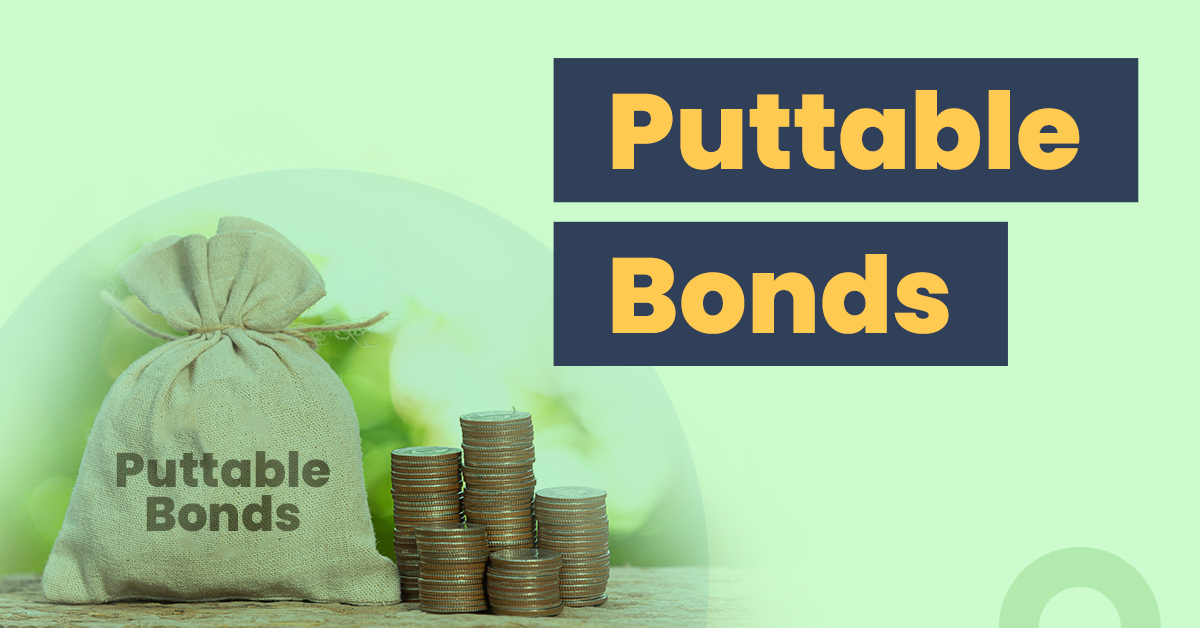Puttable Bonds: Meaning, Types, Advantages and Disadvantages


Bonds are an efficient source of financing for various entities as they help in raising capital without diluting control. Every bond comes with an expiration date, i.e., bond issuers are mandatorily liable to complete redemption on that date. However, there are several bonds that give the option of premature redemption.
Puttable bonds or put bonds are one such bond that gives you (bondholder) the right to go for early redemption before the stipulated expiry date. These bonds come with an embedded put option and are the opposite of callable bonds.
Let’s see various working aspects of this bond!
What Is a Puttable Bond?
As the name suggests, these bonds give you (bondholder) the right to force the bond issuers to buy back the debt instruments before their stipulated date. However, you are not under any obligation to exercise this right. It is completely up to you whether you want to exercise this option or not.
The bond document signed at the time of issue contains the specified time period at which you can force respective bond issuers to buy back the bonds. Moreover, the price payable by bond issuers is also mentioned in that particular document.
This inherent put option serves as an incentive for bondholders to purchase debt instruments which have a lower return. However, some put bonds allow repurchase only in case of certain extraordinary events like delays or irreparable damage caused to a project. Now that you know what puttable bonds mean let’s jump to its other aspects so that you have a complete idea about this concept.
How Do Puttable Bonds Work?
Different bonds have diverse return potentials. Puttable bonds come with a lower return outlook. In order to make it more attractive for prospective lenders, issuers incorporate a put option in these debt instruments. This option incentivises buyers to overlook the lower return outlook and purchase these bonds.
As a bondholder, you have the right to demand an early payment of the principal amount before the actual maturity date. Moreover, you can force issuers to meet their obligations subject to terms and conditions mentioned in the bond document.
Puttable bonds also have a restriction on time before which buyers cannot force bond issuers to buy back the debt instrument. Moreover, you can choose to exercise the put option and receive premature principal payment either in a lump sum manner or part by part on several specific dates.
How to Benefit from Puttable Bonds?
These bonds can be beneficial in case of rising interest rates in the market. As interest rates and bond price exhibit an inverse relationship, a rise in rates will lead to a corresponding fall in the value of bonds. In this scenario, you can exercise this put option and force issuers to purchase back their bond at par value.
After completing this transaction, you can go to the market and purchase a different bond having a high coupon rate.
What Are the Types of Puttable Bonds?
The different types of puttable bonds are as follows:
- Multi Maturity Bonds
As the name goes by, this type of bond will come with more than one maturity date. You can opt for executing the available put options at any of the maturity dates at your convenience.
- Option Tender Bonds
It is a type of floating rate bond that offers a variable coupon rate in line with the prevailing market interest rates. Examples of option tender bonds are municipal and tax-exempt bonds. You reserve the right to ask issuers to repurchase particular debt instruments before the stipulated expiry date at par value. However, this will make you lose out on future interest payments.
- Variable Rate Demand Obligation
These debt instruments come under long-term municipal bonds category. Under this, the borrowed amount is compulsorily payable before the maturity date in case of a demand for the same.
Example of Put Bonds
Let’s consider an example of a puttable bond which will help you understand this concept better. The illustration is as follows:
DEF Limited issues a put bond with a face value of ₹15,000 at an interest rate of 5% and bond tenure of 15 years. On the other hand, interest rate prevailing in the markets is 6%.
As per the bond document, holders can force sellers to repurchase the debt instruments after completion of 6 years from the date of issue.
Now, during this lock-in period, if market interest rates increase by a significant margin, the holder will not have any incentive to remain invested in this particular instrument. He/she will choose to exercise put options and use the proceeds to buy other bonds having a higher coupon rate.
On the other hand, if market interest rates fall or remain static over the entire period, investors will not see any incentive in exercising the put options and won’t purchase other bonds.
How to Calculate the Value of Put Bonds?
You can use the following formula to determine the value of put bonds:
Price of put bonds = Price of a conventional bond + Price of the put option;
Here, price of a conventional bond refers to the market price of a regular plain vanilla bond. The put option’s price represents the cost of premature redemption.
What Are the Advantages and Disadvantages of Puttable Bonds?
First, let’s discuss the various benefits of put bonds:
- These bonds come with an inherent put option. This feature will incentivise you if you opt for this instrument.
- It provides an option of liquidation in the event of any unforeseen circumstances. The early liquidation will prevent you from incurring future losses.
- For sellers, these bonds come with a low-interest rate. This enables them to opt for a cost-effective source of financing.
Now, let’s shift our focus to the disadvantages associated with this bond:
- Due to the availability of a put option, these bonds come with a lower yield than their counterparts.
- In many cases, bond issuers will provide only a small window for the exercise of the put option. If you miss out on that window, the put option will expire unexercised.
Final Word
A puttable bond is the complete opposite of callable options. The former provides bondholders with a right to redeem the respective bonds prematurely. In contrast, the latter gives bond issuers the right to exercise the call option and redeem a bond prematurely.
If you are looking to invest in a puttable bond, you should thoroughly analyse the bond document and understand the terms and conditions before investing.
Frequently Asked Questions
What are plain vanilla bonds?
Vanilla bonds are the most basic and standardised debt instruments that have a fixed interest, prefixed maturity amount and a fixed tenure. These are also known as regular or conventional bonds.
Are puttable bonds risky?
These debt instruments come with low to moderate risk. This is because, due to the inherent put options, you can liquidate them before expiry in case of an adverse loss making event.
Are puttable bonds expensive?
Due to the put option offered to bondholders with these bonds, these debt instruments have a slightly higher price than a normal conventional bond. On the other hand, the yield of these bonds is lower than their traditional counterparts.



